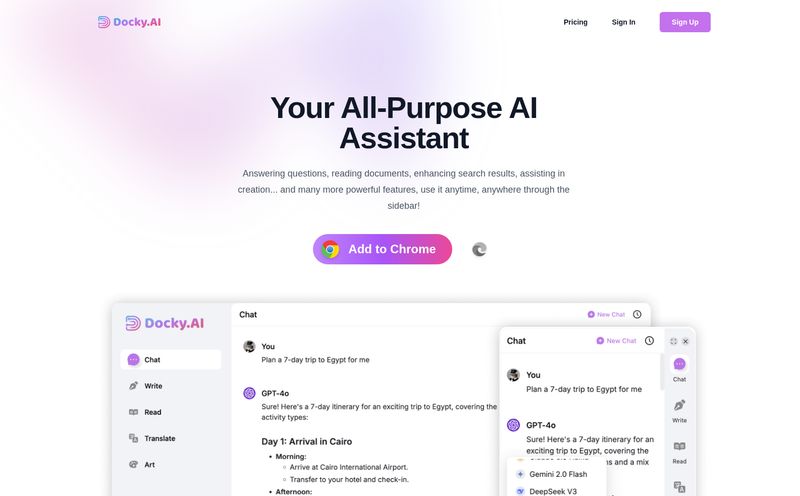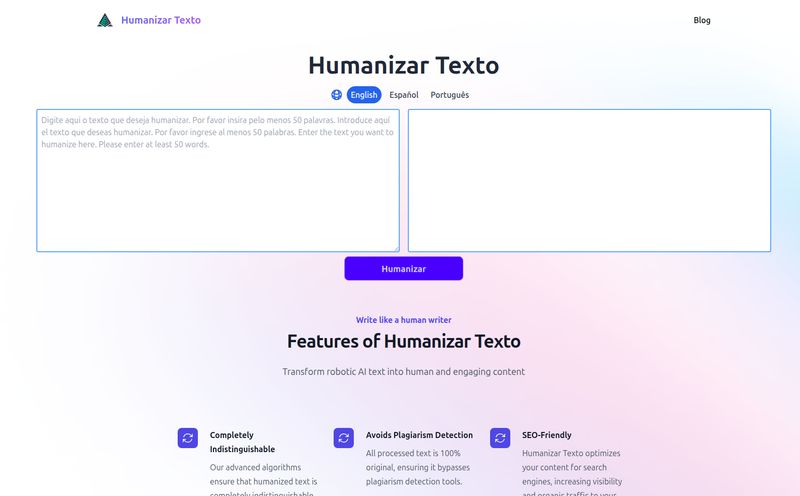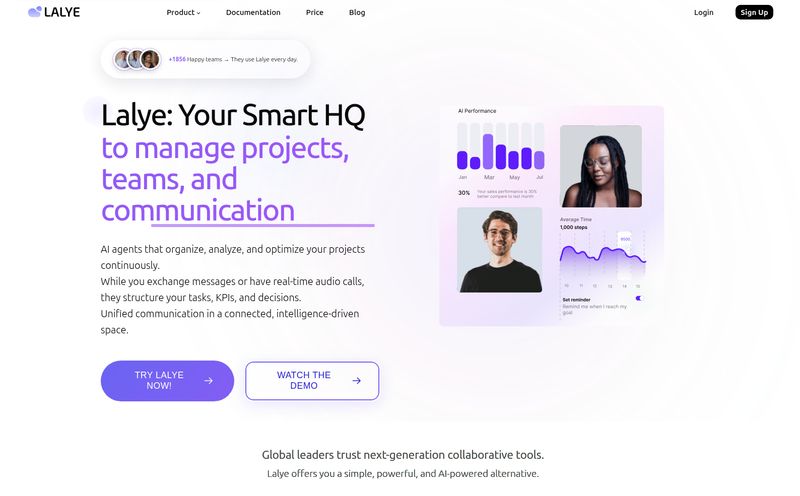In the world of SEO and digital marketing, a new AI tool pops up every other Tuesday promising to “revolutionize your workflow.” I’ve seen hundreds. Most of them are just shiny wrappers on the same old tech, and frankly, I’m a little tired of it.
So when I first heard about PixieBrix, I was skeptical. An AI-powered browser extension that lets you customize any website and automate tasks? Sounds… ambitious. It positions itself as a low-code platform to build your own in-browser 'mods.' Think of it like giving your web browser a custom-built toolkit, specifically for the sites you use every day.
But I decided to give it a proper look. And I have to say, I'm genuinely intrigued. There's something different here. It's not just about asking an AI to write an email; it's about fundamentally changing how you interact with your most-used web apps.
So, What Is PixieBrix, Really?
Forget the corporate jargon for a second. At its heart, PixieBrix is a browser extension that acts like a layer on top of the websites you already use. It’s not a separate app you have to open. It lives right there in your browser, ready to spring into action. It's like a set of LEGO bricks for the web. You can snap on a button here, an automated data-pull there, or add an AI-powered sidebar to a site that doesn’t have one.
Have you ever been working in a project management tool and wished you could just click a button to pull customer data from your CRM without switching tabs? That’s the kind of problem PixieBrix aims to solve. It bridges the gaps between your applications, stitching them together right inside your browser window.
It's built on a "low-code" philosophy, which is just a fancy way of saying you don’t have to be a hardcore developer to make cool stuff happen. If you can handle a spreadsheet formula, you can probably figure out how to build a basic mod in PixieBrix.
Who Is This Actually For? (Hint: Not Just Coders)
Initially, I thought this would be another one of those tools that’s really for developers but pretends to be for everyone. I was wrong. While developers can certainly go wild with advanced customizations and API integrations, the platform is surprisingly accessible.
I can easily see this being a massive win for:
- Customer Support Teams: Imagine having a sidebar next to a support ticket that automatically shows the customer's entire order history and previous support interactions from different systems. That’s a huge time-saver and makes for happier customers.
- Sales and RevOps: Instead of manually copying and pasting lead info from LinkedIn Sales Navigator to a CRM like Salesforce, you could build a mod to do it in one click. That’s more time for selling, less time on mind-numbing data entry.
- Human Resources: Onboarding new hires often involves a dozen different systems. A PixieBrix mod could guide a manager through the process, ensuring no steps are missed, right from their HRIS dashboard.
- Content & SEO Folks (like me!): I'm already thinking about building a mod to scrape SERP data or streamline my keyword research process across different tools. The potential is definitely there.
My Favorite Features (The Ones That Actually Matter)
A feature list is just a list. What matters is how those features solve real problems. Here’s what stood out to me.
The AI Copilot and Friends
Okay, everyone has an "AI Copilot" now. But PixieBrix’s implementation is clever. Because it's integrated into your browser, it has context. It can read the page you're on. This means you can ask it to summarize a long-winded article, draft a reply to an email based on the context of the thread, or pull specific information from a customer profile you have open. It feels less like a generic chatbot and more like a true assistant who’s looking over your shoulder (in a helpful, non-creepy way).
Building Your Own 'Mods' Without a Meltdown
This is the core of PixieBrix. They call them “mods,” which I think is a great name. It feels less intimidating than “custom integrations.” The low-code builder is a drag-and-drop-style interface where you define a trigger (e.g., “when I highlight text on a page”) and an action (e.g., “search for this text in our company knowledge base”). You can start simple and build up to more complex workflows. The fact that you can share these mods with your team is a huge plus for standardization.
Automation and Process Compliance
This one sounds a bit corporate, but it’s incredibly powerful. Most businesses have specific ways things should be done. But getting everyone to follow the process is a nightmare. PixieBrix can embed checklists, guides, and automated steps directly into the tools your team uses. It makes doing the right thing the easiest thing to do. As the testimonials from folks at companies like Billtrust and Kandji suggest, this can take a huge burden off management and improve performance across the board.
Let's Talk Money: The PixieBrix Pricing Breakdown
Alright, the all-important question: how much does it cost? The pricing structure seems pretty fair and designed to scale with you.
Here’s a simplified look:
- Free (Individual): This is a proper free tier, not just a timed trial. It's for individuals getting started and gives you a good feel for the platform with a generous amount of mods and access to 5,000 PixieBrix database records. Perfect for testing it out on your own.
- Team Plan ($10/mo/developer + $5/mo/user): This is where it gets interesting for small to medium-sized teams. You get more credits, more storage, and—crucially—the ability to collaborate and share mods. The pricing model is smart, charging more for the 'builders' and less for the 'users.'
- Business Plan ($30/user/month): This is for larger organizations that need more control. It adds things like advanced security, granular access controls, deployment groups, and a better SLA. This is your enterprise-lite option.
- Enterprise Plan (Custom): For the big players. Custom pricing for advanced needs, premium support, and all the bells and whistles.
Honestly, the fact that you can get started for free and prove its value before paying a dime is a huge green flag for me. I always appreciate a company that's confident enough in its product to do that.
The Not-So-Perfect Parts
No tool is perfect, and it would be dishonest to pretend otherwise. Based on my analysis, here are a few things to keep in mind:
First, while it's "low-code," building truly complex, multi-step automations that talk to several different APIs will probably require some technical comfort. It’s not magic. Second, its greatest strength is also a potential weakness: it relies on a browser extension. If your company has super strict policies about browser add-ons, you might face an uphill battle. Lastly, the real power comes from the premium features and API credits, so to get the most out of it for a team, you will have to invest in a paid plan.
Frequently Asked Questions about PixieBrix
- What exactly does PixieBrix do?
- It's a low-code platform in a browser extension that lets you add custom buttons, automation, and AI-powered help to any website. It helps you streamline your work without switching between a dozen tabs.
- Is there a free trial?
- Even better, there's a permanent Free plan for individuals. It’s a great way to learn the ropes and see if it’s a good fit for you without any pressure.
- Is PixieBrix secure?
- Yes, they take security seriously. The platform boasts enterprise-grade security and governance features. Data is processed in-browser whenever possible to maximize privacy, and they have clear policies on data handling for their premium features.
- What kind of apps does it work with?
- Pretty much any web application you use in your browser. Think CRMs like Salesforce, project management tools like Asana or Jira, social platforms like LinkedIn, and internal dashboards. If it's on the web, you can probably enhance it with PixieBrix.
- What are these 'premium API credits' I see in the pricing?
- These are credits used for more advanced actions, like interacting with OpenAI's models (the AI Copilot) or connecting to external APIs. The paid plans give you a larger monthly allowance of these credits.
- Is there a learning curve?
- For simple mods, no. You can get started pretty quickly. For more advanced workflows, there will be a bit of a learning curve, but their documentation and community support seem pretty solid.
Final Thoughts: Is PixieBrix Worth It?
After digging in, my initial skepticism has turned into genuine optimism. PixieBrix isn't just another AI gimmick. It’s a powerful, practical tool for anyone who feels their daily workflow is held together with digital duct tape and a prayer.
It has the potential to deliver a serious ROI by saving time, reducing manual errors, and just making work less frustrating. If you're a team lead, an operations manager, or even just an individual who's tired of clunky software, I think you owe it to yourself to try the free version.
It might just be the productivity boost you’ve actually been looking for.




